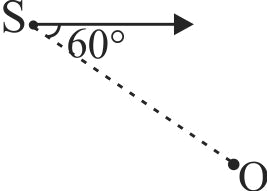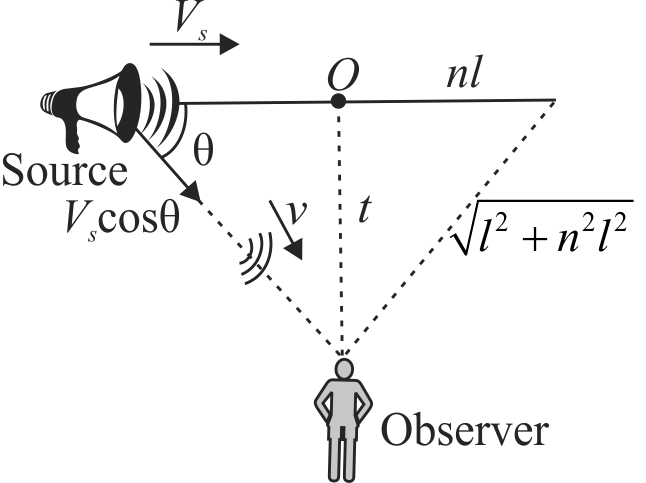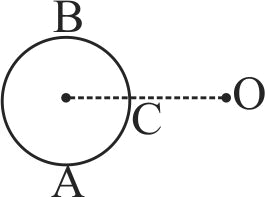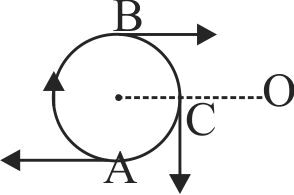354766 A car \(P\) travelling at \(20\;m{s^{ - 1}}\) sounds its horn at a frequency of \(400\;Hz\). Another car \(Q\) is travelling behind the first car in the same direction with a velocity \(40\;m{s^{ - 1}}\). The frequency heard by the passenger of the car \(Q\) is approximately [Take, velocity of sound \( = 360\;m{s^{ - 1}}\)]
354768 A source of sound having natural frequency \(f_{0}=1800 {~Hz}\) is moving uniformly along a line separated from a stationary listener by a distance \(l=250 {~m}\). The velocity of source is \(n=0.80\) times the velocity of sound. Find the frequency of sound received by the listener at the moment when the source gets closest to him.
354770
A source of sound \(S\) emitting waves of frequency \(100\;Hz\) and an observer \(O\)are located at some distance from each other. The source is moving with a speed of \(19.4\;m{s^{ - 1}}\) at an angle of \(60^{\circ}\) with the source observer line as shown in the figure. The observer is at rest. The apparent frequency observed by the observer (velocity of sound in air \(330\;m{s^{ - 1}}\)) is
354766 A car \(P\) travelling at \(20\;m{s^{ - 1}}\) sounds its horn at a frequency of \(400\;Hz\). Another car \(Q\) is travelling behind the first car in the same direction with a velocity \(40\;m{s^{ - 1}}\). The frequency heard by the passenger of the car \(Q\) is approximately [Take, velocity of sound \( = 360\;m{s^{ - 1}}\)]
354768 A source of sound having natural frequency \(f_{0}=1800 {~Hz}\) is moving uniformly along a line separated from a stationary listener by a distance \(l=250 {~m}\). The velocity of source is \(n=0.80\) times the velocity of sound. Find the frequency of sound received by the listener at the moment when the source gets closest to him.
354770
A source of sound \(S\) emitting waves of frequency \(100\;Hz\) and an observer \(O\)are located at some distance from each other. The source is moving with a speed of \(19.4\;m{s^{ - 1}}\) at an angle of \(60^{\circ}\) with the source observer line as shown in the figure. The observer is at rest. The apparent frequency observed by the observer (velocity of sound in air \(330\;m{s^{ - 1}}\)) is
354766 A car \(P\) travelling at \(20\;m{s^{ - 1}}\) sounds its horn at a frequency of \(400\;Hz\). Another car \(Q\) is travelling behind the first car in the same direction with a velocity \(40\;m{s^{ - 1}}\). The frequency heard by the passenger of the car \(Q\) is approximately [Take, velocity of sound \( = 360\;m{s^{ - 1}}\)]
354768 A source of sound having natural frequency \(f_{0}=1800 {~Hz}\) is moving uniformly along a line separated from a stationary listener by a distance \(l=250 {~m}\). The velocity of source is \(n=0.80\) times the velocity of sound. Find the frequency of sound received by the listener at the moment when the source gets closest to him.
354770
A source of sound \(S\) emitting waves of frequency \(100\;Hz\) and an observer \(O\)are located at some distance from each other. The source is moving with a speed of \(19.4\;m{s^{ - 1}}\) at an angle of \(60^{\circ}\) with the source observer line as shown in the figure. The observer is at rest. The apparent frequency observed by the observer (velocity of sound in air \(330\;m{s^{ - 1}}\)) is
354766 A car \(P\) travelling at \(20\;m{s^{ - 1}}\) sounds its horn at a frequency of \(400\;Hz\). Another car \(Q\) is travelling behind the first car in the same direction with a velocity \(40\;m{s^{ - 1}}\). The frequency heard by the passenger of the car \(Q\) is approximately [Take, velocity of sound \( = 360\;m{s^{ - 1}}\)]
354768 A source of sound having natural frequency \(f_{0}=1800 {~Hz}\) is moving uniformly along a line separated from a stationary listener by a distance \(l=250 {~m}\). The velocity of source is \(n=0.80\) times the velocity of sound. Find the frequency of sound received by the listener at the moment when the source gets closest to him.
354770
A source of sound \(S\) emitting waves of frequency \(100\;Hz\) and an observer \(O\)are located at some distance from each other. The source is moving with a speed of \(19.4\;m{s^{ - 1}}\) at an angle of \(60^{\circ}\) with the source observer line as shown in the figure. The observer is at rest. The apparent frequency observed by the observer (velocity of sound in air \(330\;m{s^{ - 1}}\)) is
354766 A car \(P\) travelling at \(20\;m{s^{ - 1}}\) sounds its horn at a frequency of \(400\;Hz\). Another car \(Q\) is travelling behind the first car in the same direction with a velocity \(40\;m{s^{ - 1}}\). The frequency heard by the passenger of the car \(Q\) is approximately [Take, velocity of sound \( = 360\;m{s^{ - 1}}\)]
354768 A source of sound having natural frequency \(f_{0}=1800 {~Hz}\) is moving uniformly along a line separated from a stationary listener by a distance \(l=250 {~m}\). The velocity of source is \(n=0.80\) times the velocity of sound. Find the frequency of sound received by the listener at the moment when the source gets closest to him.
354770
A source of sound \(S\) emitting waves of frequency \(100\;Hz\) and an observer \(O\)are located at some distance from each other. The source is moving with a speed of \(19.4\;m{s^{ - 1}}\) at an angle of \(60^{\circ}\) with the source observer line as shown in the figure. The observer is at rest. The apparent frequency observed by the observer (velocity of sound in air \(330\;m{s^{ - 1}}\)) is



